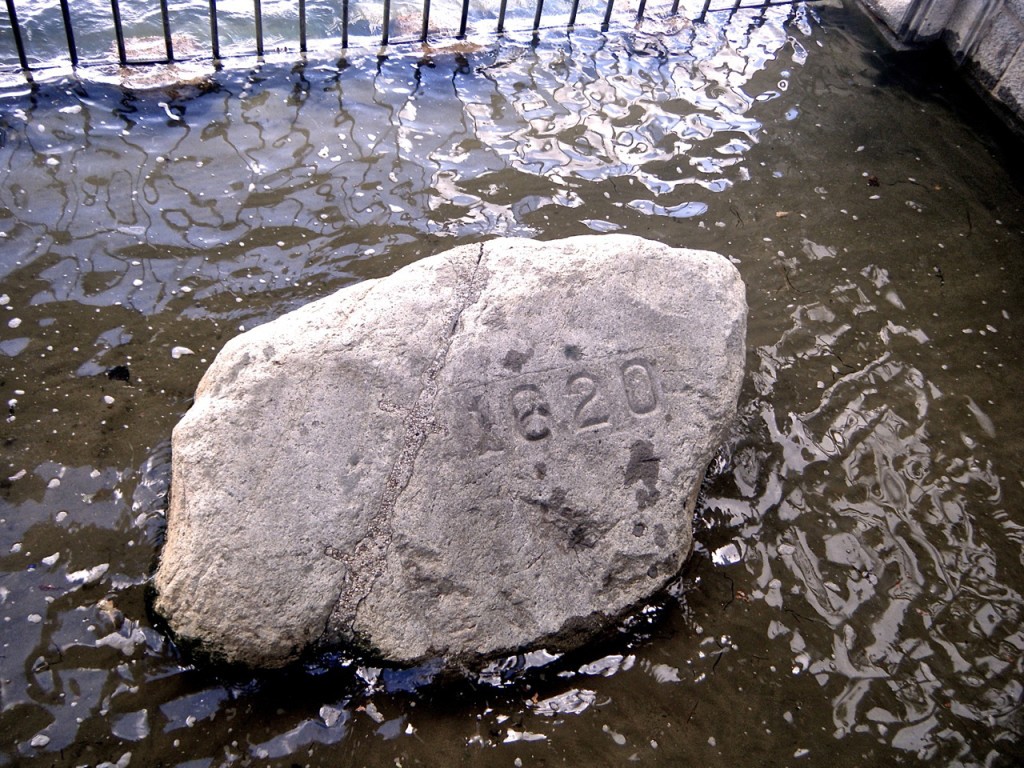Plymouth Rock: Rocking the Myth
A visit to Plymouth Rock not only generates thoughts of our nation’s intrepid beginnings, it is nearly a religious experience. This other-worldly feeling is due both to the Grecian-revival temple canopy that surrounds it and inspires reverence, and a history of American legend that has given the Rock a reputation and a mystery all its own.
The canopy over Plymouth Rock, designed by Hammatt Billings, was finished in 1867. In 1880, the Pilgrim Society moved the top of the Rock from its location in front of Pilgrim Hall Museum to reunite it with its base under the canopy. Photo courtesy of Deb Neumann, https://aroundustyroads.com/2013/03/22/challenge-1-plymouth-rock/
Nearly every American knows the elementary school version of the tale of Plymouth Rock. In 1620, the rock became the spot where the Pilgrims disembarked from the Mayflower and first set foot on American soil. In some versions, Squanto may even be there to welcome the Pilgrims with a cornucopia. Despite this likable and persistent iteration of events, history tells us that this tale is rife with inaccuracy.
Nevertheless, almost four centuries after the Pilgrims arrived, Plymouth Rock still receives over one million visitors annually.[1] The Rock, in fact, is estimated to be only about half of its original size. The top half has been moved around the town, broken, repaired, shared, and further diminished by centuries of relic hunters. This begs the question: How did Plymouth Rock become such a powerful object in the American consciousness?
There are only two primary sources written by Mayflower passengers that discuss the landing in Plymouth, and neither mention any rocks.[2] The chunk of granite was first identified as Plymouth Rock in 1741 by Thomas Faunce, a 94-year-old Plymouth church elder who was assured by his father, who arrived in Plymouth in 1623, that the boulder was the exact landing spot of the Mayflower Passengers. [3]
The Landing of the Pilgrims by Henry A. Bacon, 1877. This painting depicts the legend of 15-year-old Mary Chilton as the first Pilgrim to set foot on Plymouth Rock. Image courtesy of Pilgrim Hall Museum, http://pilgrimhallmuseum.pinnaclecart.com/wall-art/the-landing-of-the-pilgrims-henry-a.-bacon-matted-print-11-x14/
The oral tradition, established by Faunce, gained an air of the supernatural in 1774 when Plymouth residents resolved to consecrate the rock. Plymouth historian James Thacher records:
“The rock was elevated from its bed by means of large screws; and in attempting to mount it on the carriage, it split asunder. […] It is not strange that some of the patriots of the day should be disposed to indulge a little in superstition, when in favor of their good cause. The separation of the rock was construed to be ominous of a division of the British Empire” [4]
Also around this time, the first printed mention of Plymouth Rock appears. On November 29, 1775 the Pennsylvania Journal reported Naval Captain William Coit’s capture of two enemy vessels: “Captain William Coit (a humorous genius) made the prisoners land upon the same rock our ancestors first trod when they landed in America.” It seems that by the late eighteenth-century, then, Plymouth Rock was an ingrained national symbol. [5]
The date “1620” was cut into Plymouth Rock in 1880, when the top was moved under the canopy. It was also cemented to the base at that time, evidence of which is seen at the crack to the left of the inscription. Photo courtesy of https://theclio.com/web/entry?id=1511
The reason Americans are so reverent of Plymouth Rock, despite evidence that is simply an ordinary rock, is perhaps best expressed in the following quotes:
“Standing on this rock, therefore, we may fancy a magic power ushering us into the presence of our fathers. […] The hallowed associations which cluster around that precious memorial, inspire us with sentiments of the love of our country, and a sacred reverence for its primitive institutions.”
-James Thacher, History of the Town of Plymouth, 1835 [6]
“This Rock has become an object of veneration in the United States. I have seen bits of it carefully preserved in several towns in the Union. Does this sufficiently show that all human power and greatness is in the soul of man? Here is a stone which the feet of a few outcasts pressed for an instant; and the stone becomes famous; it is treasured by a great nation; its very dust is shared as a relic.”
-Alexis de Tocqueville, 1835 [7]
.
If you’d like to learn more about Plymouth Rock, click on the links below:
http://www.pilgrimhallmuseum.org/plymouth_rock.htm
or
http://www.seeplymouth.com/things-to-do/plymouth-rock
Don’t forget to comment below and share your thoughts about the true meaning of this national symbol!
.
By Kristen Semento, WPAMC Class of 2017
.
[1] http://www.seeplymouth.com/things-to-do/plymouth-rock
[2]http://www.pilgrimhallmuseum.org/plymouth_rock.htm
[3] http://www.seeplymouth.com/things-to-do/plymouth-rock
[4] James Thacher, History of the Town of Plymouth, 1835
[5] http://www.pilgrimhallmuseum.org/plymouth_rock.htm
[6] Ibid
[7] Ibid




In 11/2019 a wonderful 12 song album based on the storybook by Diane L. Finn called “The Secrets of Plymouth Rock featuring 28 Plymouth MA 4th and 5th graders singing was released. You can hear it at PlymouthRock.org. It’s the rock telling the story of the Landing of the Pilgrims up through 1921. Diane L. Finn taught elementary school in Plymouth MA for over 30 years. The storybook and the music together are sold at the Mayflower Society House, Plymouth, MA.